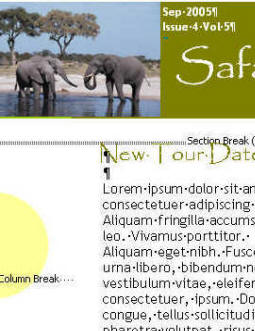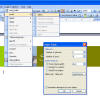Office tips blog |
Photoshop/Photography Blog |
About me |
e-mail

|
Organizing Text in WordHelen Bradley 
Helen Bradley shows how to organize text in columns in Microsoft Word.When you have information to organize on a page in Microsoft Word you may find columns let you to create a better looking document than text that flows the full width of the page. Columns not only help you to organize text in a newspaper style format where text runs through a series of narrow columns but they also work well with documents such as step by step training documents and even some reports and brochures. In this column I will show you how to organize text in columns in Word including how to create a document that looks like it is formatted in columns but, in fact, uses tables instead. I'll also show you how you can get the look of columns using linked text boxes that work best in some other situations. Iíll show you which of the techniques you should use and when.
Column Basics Columns in a Word document allow you to divide the page vertically into two or more sections so that text you type into them runs down the first section (column) until it is full and then it snakes over to start again at the top of the second section (column). When this is full, the text snakes up and begins to fill the third column, if there is one. If not, a new page is begun and the text begins to fill the first column of the new page.
These newspaper style columns are obviously the tool to use for newsletters but they also work well for training documents. You will often find you can get more text on the page if you use columns and it looks neater and more professional. In addition, text is more easily read when in columns because the column widths are shorter so the lines of text are correspondingly shorter too.
Use the columns feature to create a newspaper type document in Word.
Columns are only visible in Print Layout view so you will need to switch to this view before you can view and work with them. To do so, choose View, Print Layout. When you create a document using columns you can do this as you type the document or you can type it first and arrange it into columns later on. To format a document with columns, choose Format, Columns and select the number of columns to use. Typically, on an A4 sheet of paper, you will use two or three columns. Use two columns for training materials and, for newsletters you can use either two or three columns. The columns dialog lets you configure the number and width of columns in your document.
By default all columns are created equal in width but if you want to change this, disable the Equal column width checkbox and, instead, set your own column widths and inter column spacing. The widths are entered in the width box for each column and the spacing in the spacing box. Ensure that, if you are configuring column widths and spacing manually, that you allow adequate spacing between the columns particularly if your type will have a ragged right margin.
If you use Left justified type, then the right margin of the text will have a ragged edge. If the spacing between the two columns is too narrow, the readerís eye will be encouraged to read across the two columns instead of reading down. This is particularly the case when there isn't a neat edge to give them a visual indication that they've reached the end of the line.
The columns dialog also has an Apply to setting which lets you specify where the columns start. This is an extremely important setting, particularly in the situation where you want a heading to span the full width of the page and the columns to begin under the heading. In this situation, place your cursor where you want the columns to start and then choose Format, Columns and configure your column settings. From the Apply to list choose This Point Forward and the columns will begin at the cursor position, after the heading.
If you want a vertical line to appear between the columns, enable the Line Between checkbox Ė the line is black and a fixed width and can't be altered. When you are done, click Ok to confirm your settings. If you have the Ruler showing you will see the column markers on the ruler line. To view the ruler, choose View, Ruler.
If you haven't yet entered the text, you can now start typing in the column. When you reach the right edge of the column, the text will scroll around and begin a new line well before it reaches the right side of the page. When you fill the first column of text the text will snake back up from the bottom of the first column to the top of the second.
Managing text in columns When you want to finish a column of text before you reach the bottom of the page, press Enter once and then choose Insert, Break, Column Break and click Ok. The text will then jump to the top of the next column even though it hasnít reached the bottom of the first.
You can view the column break as you would any other special Word code by clicking the Show/Hide∂ button on the toolbar. Column breaks can be deleted like any other Word code by placing your cursor just in front of the column break and press Delete. When you do this the column break will disappear and the text will realign down the first column to fill it and only overflow into the second once the first column is full.
When you're working with columns and if you need to move between columns you can either click with your mouse or use these keyboard shortcuts. To move to the next column, choose Alt + Down Arrow and to move to the previous column, press Alt + Up arrow. These commands will only work where you already have text in the column Ė so, if the second column is empty, pressing Alt + Down arrow won't work.
Adding pictures When you are working with columns you can create pictures and Clip Art objects that span the gutter between the two columns. For example, choose Insert, Clip Art and choose an image to insert into the document. Now right click the image and choose Format, Picture, Layout tab and set the layout to Square or Tight and then click Ok. You can now drag the image over the break between two columns and, where it overlaps the text in the column, it will push the text so that it scrolls neatly around the image.
To remove columns from a document, select the text that is the subject of the columns and choose Format, Columns, One and press Ok. This will remove the columns and reinstate the text as single column which spans the full width of the page.
To create a block of text in a series of columns but which has text following it that spans the full width of the page, first select the text that should appear in columns. Now choose Format, Columns and select the number of columns to use. From the Applies To list, select Selected Text and click Ok. Now only the selected text will be formatted in columns and all text before and after it will appear as normal.
Adjusting column settings When you have text formatted in columns you can adjust the column width either by using the Columns dialog or from the Ruler Bar. To use the Ruler bar, drag on the markers at either edge of the columns and drag them to make the columns wider or narrower. If the column markers won't move when you drag on them, hold the Alt key and they will all size together. This will be the case when you have configured columns with equal column widths.
You can balance newspaper style columns so that the same amount of text appears in each column. You would do this, for example, when you have finished entering your text and when the last column is not full. Choose Insert, Break, Continuous. This adds a section break at this point in the document evening out the columns even though the end of the page has not yet been reached. Should you wish to start a new page at this point, choose Insert, Break, Page Break and click Ok. Alternatively you can simply begin a new set of columns.
If you find it difficult to see the boundaries of the columns on the page, you can enable guidelines that will help you see what is happening. To do this, choose Tools, Options, Text Boundaries and you will see the columns marked clearly on the page. Repeat these steps to disable this option if you decide you don't like the effect.
Adding tables to columns It is possible to add a table to a column layout by choosing Insert, Table and create the table as you would any regular table. A table can span two columns much as an image does. To do this, simply click in the table then drag the move button which appears at the top left corner of the table and drag the table into position over the break between two columns. Like an image, the table will push the text beneath it out of the way so it wraps around the table edges.
Hyphenation When using columns you will find that the lines of text are much shorter than they would otherwise be. This occurs where a long word that should have appeared at the end of a line has been moved to the beginning of the next line because it won't fit. The result is that there is a large gap at the end of the line and the edge of the column looks very ragged indeed.
If you wish to even up the edge of the column, you can employ the Word Hyphenation tool to hyphenate words which appear at the end of a line of text so that part of the word will fit and so the text edge is less ragged. To do this, select the text to hyphenate and choose Tools, Language, Hyphenation. Enable the Automatically Hyphenate Document checkbox and set the Hyphenation zone and the value for the Limit Consecutive Hyphens To setting and click Ok. Word will now automatically hyphenate your text and it will show a more even margin.
When lines of text are too short you can hyphenate the text so the right margin of the column is less ragged.
Another alternative for column text is to use the full justification option which is selected by the Justify button on the toolbar. This stretches the text to the full width of the column so both edges are very even and straight. This improves the look of the column.
Alternatives to Columns Sometimes columns are not the best solution to the task at hand. Here are two scenarios and solutions that do not involve columns.
Side by side paragraphs When you need paragraphs of text to appear opposite each other but in such a way that adding text to one paragraph will not affect the placement of other text on the page, use a table in preference to columns. To do this, click where the table should appear and choose Insert, Table.
Step 2 Set up your table with two columns and one row and click Ok. Click in the first cell and type the text for the first paragraph or element in your series of 'columns'. Press the Tab key and type the text that should appear opposite this. Press the Tab key and Word will add a new row to the table. Continue entering information into the table Ė each cell full of text will stay in a fixed position opposite the text in the cell opposite it.
When you are done, choose Table, Select, Table and then Format, Borders and Shading, Borders tab and click None to remove the borders from the table so they are not visible on the printed page. The result is that you get the impression of columns but ensuring the layout of your text is stable.
Text boxes When you want text to flow through a document but not placed neatly in snaking columns and perhaps with other text interspersed with it, linked text boxes are a good choice. To create these, choose Insert, Text Box and drag to create a text box on the page.
Step 2 Type the text into the text box. If there is too much text to fit in the text box click Insert, Text Box and draw a second textbox. It doesn't matter where in the document you do this, except that the second text box should appear after the first.
Step 3 To link the two text boxes ensure the Text Box toolbar is visible and, if not, choose View, Toolbars, Text Box to display it. Click on the first text box and click the Create Text Box link button on the Text Box toolbar. Now click in the middle of the second text box to link the two. Overflow text now flows from one text box to fill the other.
Article first published in Australian PC User magazine (c) Helen Bradley 2007-2009
|






